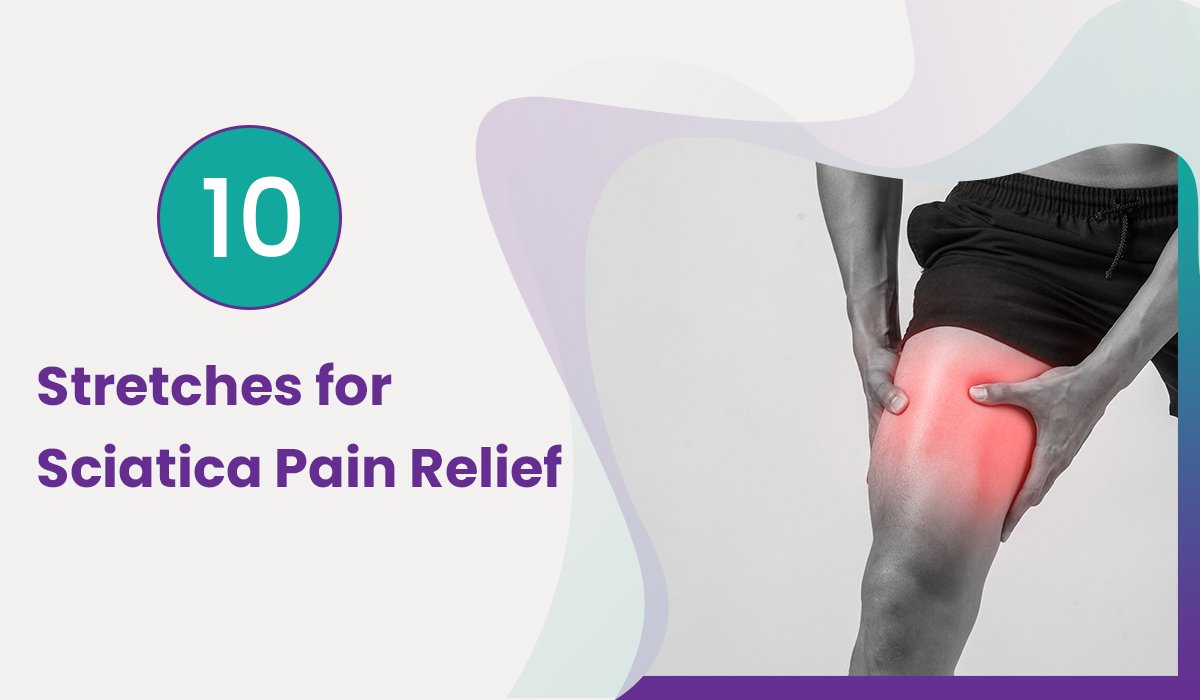10 Stretches for Sciatica Pain Relief
Tightness in your lower back, abdominal, and/or hamstring muscles can aggravate sciatic pain, which extends from your lower back to your feet. Perform these ten simple stretches for Sciatica to loosen and strengthen muscle groups.
What is the Sciatic Nerve?
Sciatic nerve pain or Sciatica pain might be so painful and incapacitating that you don’t want to get out of bed. Because this ailment is rather prevalent, with a lifetime incidence of 10 to 40, you most likely know more than one person who has it.
The sciatic nerve starts in your lower back, hips, and buttocks and travels down each leg, bending at the knees. Sciatica occurs when there is an issue somewhere along this pathway. Stretches for back pain can help you to get rid of these.
Sciatica pain can be caused by a variety of factors, including:
- A disc ruptures
- Spinal canal narrowing (called spinal stenosis)
- Injury
Sciatic pain can also be caused by a disorder known as piriformis syndrome. The piriformis muscle runs from your buttocks along the spine’s border to the top of your thigh. This muscle can sometimes spasm and entrap the neighboring sciatic nerve. It can cause sciatic pain. There are various sciatica pain relief but stretches for Sciatica pain are the most effective.
10 stretches for back pain that can help you achieve Sciatica pain relief:
- Reclining pigeon pose
- Sitting pigeon pose
- Forward pigeon pose
- Knee to the opposite shoulder
- Sitting spinal stretch
- Standing hamstring stretch
- Basic seated stretch
- Standing piriformis stretch
- Groin and long abductor muscle stretch
- Scissor hamstring stretch
All the stretches for back pain mentioned above are explained in this article. Keep on reading if you are looking for Sciatica Pain relief!
Reclining Pigeon Poses
The reclining pigeon stance is one of the numerous pigeon stretches for Sciatica Pain that can help stretch the piriformis muscle.
- While lying on your back, raise your right leg to a right angle. Clasp both hands behind the thigh, fingers locked.
- Raise your left leg, placing your right ankle on top of your left knee.
- Hold the position for a few seconds. It stretches the piriformis muscle, which can become irritated and push on the sciatic nerve, producing pain. It stretches all the deep hip rotator muscles as well.
- Repeat the exercise with the opposite leg.
Sitting Pigeon Pose
It is one of the most effective stretches for Sciatica pain. For this follow these:
- Sit with your legs straight out in front of you on the floor.
- Bend your right leg, so your right ankle rests on your left knee.
- Lean forward and reach your upper body toward your thigh.
- Maintain for 15 to 30 seconds. The glutes and lower back are stretched because of this.
- Repeat on the opposite side.
Forward Pigeon Poses
If you are looking for Sciatica Pain Relief, it is one of the most recommended stretches for back pain for you!
- Get down on all fours and kneel on the floor.
- Pick up your right leg and move it forward in front of your body on the ground. Your lower leg should be parallel to the ground and parallel to the body. Your right foot should be in front of your left knee, and your right knee should remain to the right.
- Extend your left leg all the way behind you on the floor, top of your foot on the ground, toes pointing back.
- Gradually shift your body weight from your arms to your legs so that your legs support your weight. Straighten your back and place your hands on either side of your legs.
- Take a long, deep breath. Exhale as you lean forward over your front leg. As much as possible, support your weight with your arms.
- Repeat on the opposite side.
Knee to the Opposite Shoulder
This is one of the easiest stretches for Sciatica pain that relieves sciatica pain by releasing the gluteal and piriformis muscles, which can become irritated and press against the sciatic nerve.
- Lie on your back, legs extended, and feet flexed upward.
- Bend your right knee and wrap your hands around it.
- Pull your right leg across your body toward your left shoulder gently. Hold it there for 30 seconds. Remember just to pull your knee as far as it will comfortably allow. You should sense a relaxing stretch in your muscle rather than discomfort.
- Return your leg to its starting position by pushing your knee.
- Repeat for a total of three repetitions, then switch legs.
Sitting Spinal Stretch
When the vertebrae in the spine compress, sciatica pain occurs. This stretch opens the spine and relieves pressure on the sciatic nerve resulting in Sciatica pain relief.
- Sit on the ground with your legs straight out in front of you, and your feet flexed upward.
- Bend your right knee and place your foot flat on the floor outside your opposite knee.
- Gently move your body to the right by placing your left elbow on the outside of your right knee.
- Hold for 30 seconds and repeat three times more before switching sides.
Standing Hamstring Stretch
This stretch can help relieve sciatica-related hamstring discomfort and tightness.
- Place your right foot on an elevated surface at or below the level of your hips. It might be a chair, ottoman, or stair step. Flex your foot to straighten your toes and leg. Maintain a modest bend in your knee if it tends to hyperextend.
- Slightly bend your body forward toward your foot. Don’t push yourself too hard to the point of pain.
- Lower the hip of your lifted leg rather than pulling it up. If you need assistance lowering your hip, wrap a yoga strap or long exercise band around your right thigh and under your left foot.
- Hold for at least 30 seconds, then switch sides.
Basic Seated Stretch
Sit on a chair and cross your troublesome leg over the knee of your other leg to begin one of the most popular stretches for Sciatica pain. Then take the following steps to achieve Sciatica pain relief.
- Bring your chest forward and attempt to keep your spine straight. Try to bend over a little more if it isn’t painful. If you experience any pain, stop.
- Hold this position for 30 seconds before doing the exercise with the opposite leg.
Standing Piriformis Stretch
Another standing stretch that can help with sciatica pain is this one. If you’re able, you can do this without assistance or stand against a wall with your feet about 24 inches away from the wall.
- While standing, cross your sore leg over the knee of your other leg. Bend your standing leg and try to make the number 4 with your hips at a 45-degree angle to the ground.
- Bend your knees and swing your arms down, keeping your back straight. Maintain your position for 30 to 60 seconds.
- Change legs and repeat.
Groin and Long Adductor Muscle Stretch
This stretch demands you to sit on the floor with your legs as wide apart as possible straight in front of you.
- Place your hands on the ground in front of you and tilt your torso toward the ground.
- With your elbows on the floor, lean forward. Hold this pose for 10 to 20 seconds. If you experience any pain, stop.
Scissor Hamstring Stretch
The ischial tuberosity, commonly known as the sit bones, begins at the ischium, which, combined with the ilium and pubis, forms the pelvic girdle.
The hamstring muscles are connected to the ischial tuberosity via the Sacro tuberous ligament (STL). Hamstring muscles, when tense, can mimic sciatica symptoms.
This stretch can help release the hamstring muscles, relieving strain on the sciatic nerve. It may be beneficial to perform this exercise daily.
- Position your right foot approximately 3 feet behind your left foot.
- Draw your hips forward and back, but your right hip should not be more forward than your left hip. A mirror could help you decide this.
- Place both hands on your hips. If you need to balance, you can utilize a chair.
- Bend your waist while keeping your back straight and push your torso slightly over your front leg. Maintain your weight on your front leg.
- Hold this position for 5 to 10 seconds before repeating with the opposite leg. Stretch each leg three to five times.
Lastly
If you are still not able to achieve Sciatica pain relief after performing all these stretches for back pain, kindly consult an expert. And when it comes to experts for all these issues, no experts can be compared with the quality treatment provided by the trained professionals at Om Physio Plus Nutrition. The team of professionals will provide you with best-in-class treatment that will help you to get rid of Sciatica Pain.


